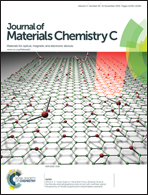Highly sensitive, temperature-dependent gas sensor based on hierarchical ZnO nanorod arrays†
Abstract
The low-cost growth of patterned zinc oxide (ZnO) nanorod arrays (NAs) has attracted much attention with the rapid development of electronics and nanotechnology. A mechanoelectrospinning-assisted continuous hydrothermal synthesis method (MES-CHSM) is proposed to direct-write the precursor patterns for the growth of the ZnO-NAs, in a digital, low-cost, and mask-free manner. The morphology and distribution of the hierarchical ZnO nanorods, having a tremendous impact on the gas response, are determined by the process parameters of the MES-CHSM. It is highly desirable that the diameter, interval, orientation and distribution of the ZnO nanorods can be tuned proactively by changing the growth time, the solution concentration, the nature of the precursor layer, and the pattern by MES. The ZnO-NAs exert excellent Ohmic contact with interdigital electrodes when exposed to dry air, NO2 gas and then dry air again. The gas response of the ZnO sample is surface-reaction-determining. The gas sensing results show highly sensitive and repeatable response–recovery cycles following NO2 gas exposure and air purging, respectively. The dynamic response of the gas sensor shows a temperature-dependent response to NO2, even at low concentrations (1–50 ppm). The best gas response is located between 200 °C and 225 °C. Gas sensors, prepared by different process parameters, show two laws regarding the corresponding responses and the NO2 concentrations: approximately linear and saturation regions. The optimal process parameters are presented to postpone the occurrence of the saturation region, to enlarge the measuring range.


 Please wait while we load your content...
Please wait while we load your content...